Parallelogram 12 • Level 4 • 20 Nov 2025KenKen Level 4
Noun: Parallelogram Pronunciation: /ˌparəˈlɛləɡram/
- a portmanteau word combining parallel and telegram. A message sent each week by the Parallel Project to bright young mathematicians.
- Tackle each Parallelogram in one go. Don’t get distracted.
- Finish by midnight on Sunday if your whole class is doing parallelograms.
- Your score & answer sheet will appear immediately after you hit SUBMIT.
- Don’t worry if you score less than 50%, because it means you will learn something new when you check the solutions.
1. KenKen
Today’s Parallelogram is dedicated to KenKen – a mathematical puzzle that is ten times more interesting than Sudoku.
First of all, these are the rules.
- You will be presented with a 3 x 3 grid.
- Each row and each column contain the numbers 1, 2 and 3 once and only once.
- Therefore, no number can be repeated in a row or column.
- Each marked region (or cage) contains a target number and a mathematical operation. The numbers in the cage must add up, subtract, multiply or divide to give the target number.
- The ordering of the numbers does not matter in a cage. So, 2 followed by 1 or 1 followed by 2 can both give the target (1,−), which means reaching the target 1 by subtraction.
- If the cage contains just 1 cell, the value of the cell is the same as the target number. it is a “freebie”.
- There are also 4 x 4 grids, and each row contains the numbers 1, 2, 3 and 4 once and only once. There are also even bigger grids.
This video summarises the rules of KenKen.
If you’re still unsure, this video goes through the rules one more time.
(If you have problems watching the video, right click to open it in a new window)1.1. Here is your first KenKen. The only mathematical operation is addition.
You can either copy it onto a bit of paper by hand or follow this link to open a copy of all of the questions that you can print and fill in.
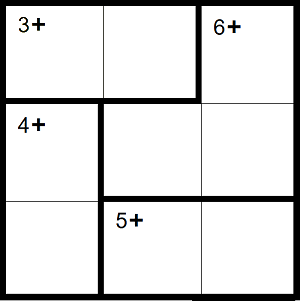
To help us check whether you have completed the grid correctly, add up the 4 corner numbers and enter the sum in the box below.
The (4 +) cage is one way to start cracking this KenKen. The cage has to contain (3,1), because the only other way to obtain 4 is (2, 2) and no number can be repeated in a row. We don’t know the order of the (3, 1) cage, but it tells us the remaining number in that column must be (2).
Correct Solution: 8
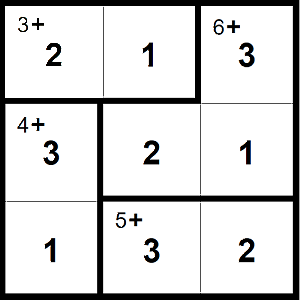
2. Two more KenKens
2.1. This KenKen involves multiplication, division and subtraction. What do the four corner cells add up to?
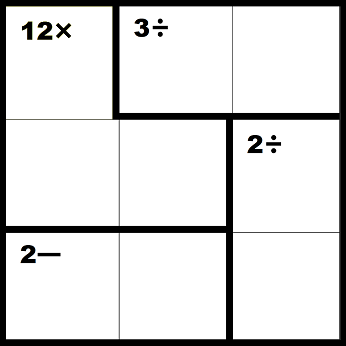
Look at the (12x) cage. It can only contain the numbers (3, 2, 2), but the 2s cannot be in the same row or column, so where must they be placed?
Correct Solution: 8
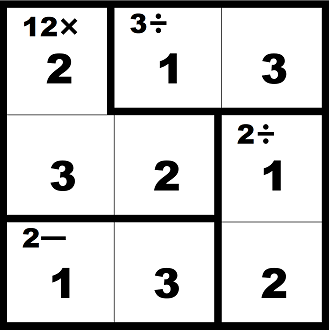
2.2. This KenKen involves multiplication and division only, but it’s a 4x4 grid.
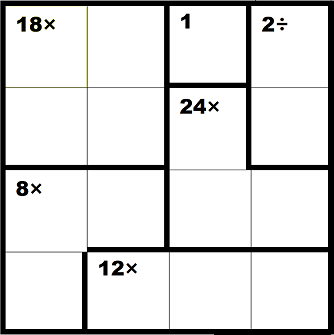
What do the four corner cells add up to?
Okay, this is harder than I thought. Of course, fill in the freebie (1). Then, the (18x) cage has to be (3, 3, 2, 1). The (3, 3) have to be diagonal to each other in the cage, to avoid being in the same row/column. Therefore, the (2,1) have to be diagonal to each other – one is in the top row and one is in the second row. In fact, the 1 has to be in the second row, because we already have a 1 in the top row. So, the 2 has to be in the top row.
So, in the top row, we know we have a 3 and a 2 in the (18x) cage, and then a freebie (1), so the right cell in the top row must be (4).
If the top right cell is (4), from the first hint, the cell below it must be 2. The cell below that is part of the (24x) cage, which consists of (4, 3, 2). However, the right-hand column already has a (4, 2), so the third element of the right-hand column must be (3).
Correct Solution: 10
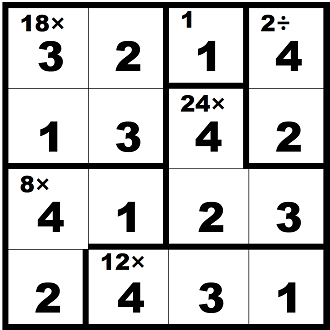
3. KenKen (5x5)
3.1 This KenKen involves only addition and subtraction, BUT it is a 5x5 grid!
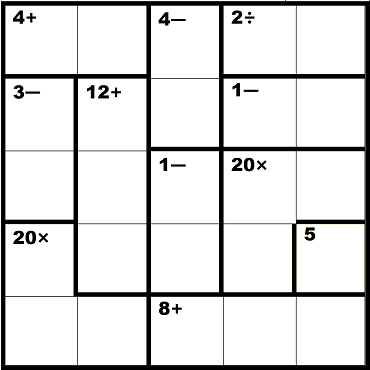
What do the four corner cells add up to?
The (4+) cell has to contain (3,1) in some order, as (2,2) is not allowed, because you cannot repeat any number in the same row/column.
Both (20x) cages have to be either (5, 4, 1) or (5, 2, 2). Either way, there is a 5 somewhere. Given the freebie (5) in the right column, we know the (5) sits in the middle of the (20x) cage on the right
The (12+) cage must have three different numbers, because it sits in one column. Those numbers must be (5, 4, 3).
The first hint showed that the (4+) cage must be (3,1), and now we know it must be in that order to avoid a repeated (3) in the second column.
Don’t worry if you needed all four hints – this is not an easy KenKen. Two clues in this hint.
(1) In the (12+) cage, which must contain (5,4,3), the 5 must be at the top of the cage to avoid being in the same row as any other (5).
(2) This forces the last (5) into the bottom-left corner.
Correct Solution: 11
(This is your last KenKen... unless you have now caught the KenKen bug? Your teachers might want to introduce KenKen into the classroom, and you can find more for yourself by visiting kenkenpuzzle.com)
KenKen® is a registered trademark of KenKen Puzzle, LLC. Copyright KenKen Puzzle. All rights reserved.
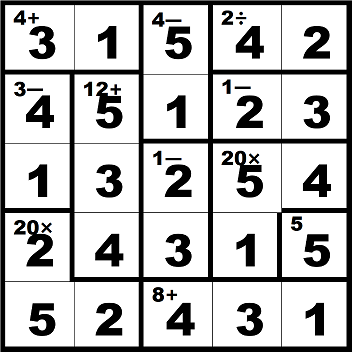
4. Intermediate Maths Challenge Problem (UKMT)
4.1 What is the value of
250 380 1 4 390 1 4 395 399 3 4 - (Not answered)
Since in the IMC we are not allowed to use a calculator, we should look for a better method than just multiplying the two given numbers.
The clue is that both numbers differ from 20 by
This gives
Before you hit the SUBMIT button, here are some quick reminders:
- You will receive your score immediately, and collect your reward points.
- You might earn a new badge... if not, then maybe next week.
- Make sure you go through the solution sheet – it is massively important.
- A score of less than 50% is ok – it means you can learn lots from your mistakes.
- The next Parallelogram is next week, at 3pm on Thursday.
- Finally, if you missed any earlier Parallelograms, make sure you go back and complete them. You can still earn reward points and badges by completing missed Parallelograms.
Cheerio, Simon.